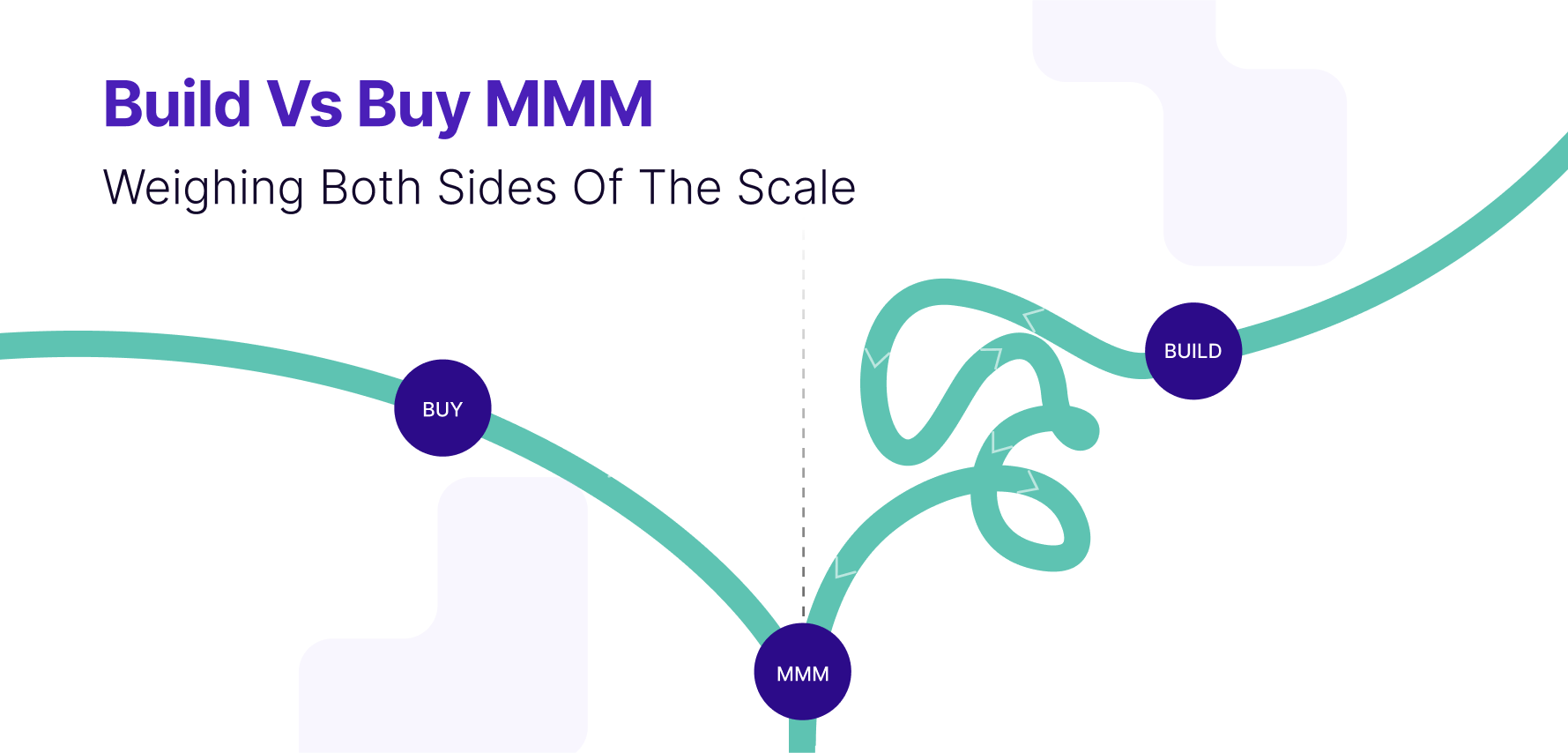Measuring the real impact of digital marketing campaigns has become one of the biggest challenges for modern businesses. Traditional metrics like clicks, impressions, or ROAS only provide a partial view, often leaving marketers unsure about what is truly driving growth.
Many marketers fall into the trap of relying solely on in-platform attribution, which often overstates results and ignores the broader customer journey. Optimizing campaigns based only on what platforms report usually drives up CPCs and CPMs without delivering true incremental growth. To avoid this, businesses need to look beyond platform dashboards and adopt more holistic measurement approaches.
A Digital Marketing Measurement Model (DMMM) solves this problem by combining advanced methodologies such as Marketing Mix Modeling (MMM), Incrementality Testing, and Causal Attribution. With a DMMM in place, businesses gain clear, actionable insights that eliminate wasted spend, improve accountability, and align every marketing effort with measurable business outcomes.
What is a Digital Marketing Measurement Model (DMMM)?
A Digital Marketing Measurement Model (DMMM) is a set of advanced marketing approaches that helps marketers assess the effectiveness of their digital campaigns and attributed efforts. It ultimately provides a clear view of which campaigns and initiatives are the true drivers of overall business success.
To achieve this, the DMMM framework tracks advanced marketing KPIs beyond ROAS, such as Incremental ROAS (iROAS), Incremental CAC (iCAC), Marginal CAC (mCAC), and more.
Why Should Businesses Need a Digital Marketing Measurement Model?
Businesses should adopt a Digital Marketing Measurement Model (DMMM) to truly understand the effectiveness of their digital campaigns and marketing efforts. By tracking advanced KPIs, companies gain a clear view of what’s working and what’s not. This clarity enables marketers to allocate budgets more effectively, eliminate wasted ad spend, and transform investments into profitable growth.
A well-structured DMMM provides not just insights but also actionable strategies, ensuring that every marketing dollar contributes to measurable business outcomes.
Here’s the key reasons for businesses to have digital marketing measurement models (DMMMs) in their marketing teams.
1. Unified Reporting
The first step toward clarity is consolidating data. A DMMM unifies all marketing data into a single reporting system, eliminating fragmented tools and conflicting platform dashboards. This creates a single source of truth for decision-making.
2. Full Funnel Measurement
Once data is unified, marketers can track performance across the entire funnel, from awareness to conversion. This ensures strategies are optimized not only for immediate sales but also for long-term brand growth.
3. Cross-Channel Attribution
With full-funnel visibility, the next step is understanding how different channels interact. A DMMM applies advanced attribution models to show how touchpoints across social, search, email, and display collectively drive conversions.
4. Effective Budget Allocation
Armed with attribution insights, marketers can reallocate budgets to campaigns and channels that actually drive incremental business outcomes. This prevents over-investment in underperforming efforts.
5. Optimize the Spend Level
Even top-performing campaigns reach a point of diminishing returns. A DMMM identifies the optimal spend level for each channel, ensuring budgets are not just allocated effectively but also scaled efficiently.
6. Actionable Recommendations
With optimized spend levels, the framework provides data-driven recommendations that marketers can act on immediately. Instead of static reporting, DMMM transforms data into clear strategies for improvement.
7. New Channel Opportunities
Actionable insights often reveal untapped growth areas. By analyzing performance holistically, a DMMM helps marketers identify new channels that can expand reach and drive incremental ROI.
8. Adapt to Seasonality and Promotions
Once new opportunities are identified, businesses can fine-tune their strategies to adapt to seasonality, holidays, and promotional cycles. This ensures maximum efficiency during high-demand periods.
9. Scenario Planning and Forecasting
With ongoing performance insights, businesses can model different spend scenarios and forecast future outcomes. This prepares teams for shifts in the market and allows proactive strategy adjustments.
10. Justify Marketing Spends
Ultimately, a DMMM builds transparency and accountability. By connecting spend directly to outcomes, marketers can confidently justify their investments to leadership and stakeholders.
What will Businesses Miss if they don’t have Digital Marketing Measurement Models?
Without a Digital Marketing Measurement Model (DMMM), businesses risk making decisions based on incomplete, biased, or fragmented data. This not only weakens marketing performance but also leads to wasted resources, missed opportunities, and unreliable growth. A lack of a proper framework turns marketing into guesswork instead of a predictable, profitable engine.
Here are the key challenges businesses face without a DMMM:
1. Relying on Siloed Tools and Biased Reports
Without a unified measurement model, businesses depend on platform-reported metrics that often present a biased or incomplete picture. This makes it difficult to see the true contribution of each channel.
2. Data Fragmentation
Marketing data gets scattered across multiple tools and platforms. When teams cannot connect these data points, insights become inconsistent, and strategy alignment suffers.
3. Guesswork in Decision-Making
Without a reliable measurement framework, marketers end up making decisions based on assumptions rather than evidence. This leads to inconsistent performance and wasted opportunities.
4. Tracking Only Traditional KPIs
Businesses that focus only on surface-level metrics like ROAS or CTR miss the bigger picture. Advanced metrics such as iROAS, iCAC, and mCAC reveal incremental value, but without DMMM, they remain unmeasured.
5. Prioritizing Underperforming Campaigns
In the absence of advanced measurement, underperforming campaigns may appear successful on surface-level metrics. As a result, businesses may unknowingly continue investing in areas that do not drive incremental growth.
6. Wasted Ad Budgets
Inefficient spending is inevitable without clarity on what truly works. Budgets flow into campaigns with low impact, and businesses fail to maximize profitability.
7. Misallocating Resources
Teams and budgets often get directed toward the wrong priorities. Without accurate measurement, resources are wasted on campaigns that look good in reports but fail to deliver meaningful business outcomes.
Types of Digital Marketing Measurement Models and Frameworks
A Digital Marketing Measurement Model (DMMM) can be built using different types of frameworks. Each framework provides a unique lens for evaluating campaign performance, and together they form a comprehensive approach to measuring effectiveness.
Here are the three core types of measurement frameworks:
1. Modeling Framework
The Modeling Framework relies on statistical and mathematical models to analyze historical data. It identifies patterns, relationships, and trends between marketing activities and business outcomes such as sales, leads, or customer behavior. This approach allows businesses to simulate how changes in spend or strategy may impact future results.
1.1 Marketing Mix Modeling (MMM)
Marketing Mix Modeling (MMM) is a widely used method within the modeling framework. It evaluates how different elements of the marketing mix such as advertising spend, pricing, promotions, and distribution contribute to overall performance. By quantifying the impact of each channel, MMM helps businesses optimize resource allocation and maximize ROI.
2. Experimentation Framework
The Experimentation Framework focuses on testing and validating strategies through controlled experiments. Instead of relying on correlations, it measures the causal impact of marketing efforts on outcomes. This method allows businesses to test hypotheses, refine campaigns, and continuously improve based on evidence. Common approaches include A/B testing, multivariate testing, and audience split testing, each enabling marketers to isolate variables and understand what truly drives performance.
2.1 Incrementality Testing
Incrementality Testing is a key technique in this framework. It measures the true lift created by marketing campaigns by comparing results between exposed groups (who see the campaign) and unexposed groups (who do not). This approach reveals whether a campaign actually drives incremental results and avoids overestimation of performance from external factors.
Two common incrementality methods are geo testing, which compares performance across different geographic regions, and time testing, which evaluates outcomes by alternating campaign exposure over different time periods.
3. Attribution Framework
The Attribution Framework assigns credit to the different touchpoints a customer interacts with along their journey. Instead of giving all credit to a single channel, attribution frameworks reveal how multiple channels collectively influence conversions. This provides a more realistic view of what drives success.
3.1 Platform Based Attribution
Platform-Based Attribution assigns credit within individual platforms such as Google Ads or Facebook Ads. While this provides useful insights into platform-level performance, it often fails to capture cross-channel interactions and can result in siloed measurement.
3.2 Multi-Touch Attribution (MTA)
Multi-Touch Attribution (MTA) distributes credit across all touchpoints a customer engages with before converting. This helps businesses understand how various channels such as search, email, and social work together to influence outcomes. MTA provides a more complete view of the customer journey but may still lack causal clarity.
3.3 Causal Attribution
Causal Attribution is the most advanced form of attribution. It uses statistical techniques to establish cause-and-effect relationships between marketing activities and outcomes. Unlike correlation-based models, causal attribution identifies the true impact of each marketing effort and allows businesses to optimize strategies with greater confidence.
Introducing Unified Marketing Measurement Model to Measure Digital Marketing Campaigns
The Unified Marketing Measurement Model integrates Modeling, Experimentation, and Attribution framework into a single cohesive system. This creates a holistic approach to measuring digital marketing performance, ensuring that insights are accurate, comprehensive, and actionable. By connecting data across channels and applying multiple measurement methods together, the UMMM eliminates biases and provides a complete view of campaign effectiveness.
With this unified model in place, marketers can:
- Break down silos by consolidating data from all channels into a single framework.
- Gain a full-funnel perspective that connects awareness, consideration, and conversion outcomes.
- Validate results with incrementality testing to separate real impact from noise.
- Measure cross-channel contributions and understand how platforms interact.
- Allocate budgets with confidence using insights grounded in both historical modeling and real-time testing.
The Unified Marketing Measurement Model acts as a single source of truth for businesses, enabling them to align marketing strategies with measurable business outcomes. By moving beyond isolated frameworks and combining the best of each approach, it empowers companies to optimize investments, forecast performance, and prove the true ROI of digital marketing campaigns.
How Digital Marketing Measurement Models (DMMM) Work?
A Digital Marketing Measurement Model (DMMM) works by combining multiple advanced techniques into one structured process. By using Marketing Mix Modeling (MMM), Incrementality Testing, and Causal Attribution, businesses can accurately measure the impact of their campaigns, optimize spending, and connect marketing investments directly to business outcomes.
Here is how it works in practice:
1. Data Collection
The model begins with gathering data from all marketing sources, including online and offline channels. This ensures that performance is evaluated holistically rather than in silos.
2. Marketing Mix Modeling (MMM)
MMM analyzes historical data to identify patterns and relationships between marketing activities and business results such as sales, leads, or revenue. It quantifies the contribution of each channel and helps forecast how changes in budget allocation will affect future outcomes.
3. Incrementality Testing
Once baseline performance is understood, incrementality testing is applied to measure the true lift created by campaigns. By comparing exposed groups to control groups, businesses can identify which efforts are actually driving incremental results rather than relying on correlations or platform-reported metrics.
4. Causal Attribution
Causal attribution builds on incrementality testing by using statistical techniques to establish clear cause-and-effect relationships between marketing actions and business outcomes. This method removes bias and external noise, ensuring each channel and campaign is credited based on its real impact.
5. KPI Tracking
Throughout the process, advanced KPIs such as incremental ROAS (iROAS), incremental CAC (iCAC), and marginal CAC (mCAC) are tracked. These metrics go beyond surface-level reporting and highlight the efficiency and profitability of digital campaigns.
6. Insights and Optimization
The findings from MMM, incrementality testing, and causal attribution are translated into actionable insights. Marketers can reallocate budgets, adjust strategies, and prioritize channels that deliver measurable business growth.
7. Scenario Planning and Forecasting
Finally, the model allows businesses to run simulations and forecast outcomes under different scenarios. This prepares marketing teams to adapt strategies for seasonality, promotions, or market shifts with confidence.
A DMMM works as a continuous cycle, combining MMM, incrementality testing, and causal attribution to ensure that marketing performance is measured accurately, validated through experiments, and aligned with long-term business objectives.
Advanced KPIs for Digital Marketing Campaigns
1. Return on Ad Spend (ROAS) vs. Incremental ROAS (iROAS)
ROAS = Total revenue from ads ÷ Total ad spend.
iROAS = Incremental revenue caused by ads ÷ Ad spend.
How it helps: iROAS filters out revenue that would have happened anyway, showing the true impact of ads. It helps calibrate budgets more accurately.
2. Customer Acquisition Cost (CAC) vs. Marginal ROAS (mROAS)
CAC = Total cost ÷ Customers acquired.
mROAS = Return on the next dollar spent.
How it helps: CAC shows historical efficiency, while mROAS reveals future efficiency, helping identify when additional spend will no longer be profitable.
3. Attribution vs. Incrementality
Attribution = Allocates credit to touchpoints along the customer journey.
Incrementality = Measures causal lift through experiments or modeling.
How it helps: Attribution shows correlation, while incrementality uncovers true cause-and-effect, ensuring decisions are based on real impact.
4. Forecasted Revenue vs. Measured Lift
Forecasted Revenue = Predicted outcomes using historical models.
Measured Lift = Actual incremental performance observed through tests.
How it helps: Comparing forecasts with measured lift ensures predictions stay realistic and avoids overconfidence in modeled projections.
5. ROI vs. ROMI (Return on Marketing Investment)
ROI = (Total Revenue – Total Cost) ÷ Total Cost.
ROMI = (Revenue Attributed to Marketing – Marketing Cost) ÷ Marketing Cost.
How it helps: ROI measures overall business profitability, while ROMI isolates marketing’s contribution, making it easier to justify marketing investments.
6. CTR vs. Incremental Engagement Rate
CTR = Clicks ÷ Impressions.
Incremental Engagement Rate = Additional clicks directly caused by ads vs. baseline behavior.
How it helps: Incremental engagement highlights whether clicks were influenced by ads, not just natural behavior, ensuring engagement is meaningful.
7. Cost per Lead (CPL) vs. Incremental CPL
CPL = Total cost ÷ Leads generated.
Incremental CPL = Cost per additional lead created by the campaign.
How it helps: Incremental CPL shows whether campaigns are driving new demand or simply capturing existing intent.
8. Brand Awareness vs. Brand Baseline Lift
Brand Awareness = General visibility or recall measured through surveys or media metrics.
Brand Baseline Lift = Incremental improvement in awareness compared to historical baseline.
How it helps: Baseline lift isolates true campaign-driven brand growth, helping assess long-term brand equity impact.
Best Digital Marketing Measurement Model
1. Lifesight’s Unified Marketing Measurement Model
Lifesight offers one of the most comprehensive digital marketing measurement platforms available today. It combines the power of Marketing Mix Modeling (MMM), Incrementality Testing, and Causal Attribution into a single unified system, giving businesses a complete and accurate view of their digital marketing performance.
By consolidating data across platforms and channels, Lifesight provides marketers with a single source of truth. This eliminates siloed reporting and ensures that marketing decisions are based on consistent, reliable insights rather than biased platform metrics.
Key benefits of Lifesight’s Unified Marketing Measurement Model include:
- Full-funnel visibility across awareness, engagement, and conversion.
- Cross-channel insights that reveal how different platforms work together to drive outcomes.
- Incremental performance measurement to distinguish real impact from noise.
- Scenario planning and forecasting that helps businesses prepare for seasonality, market changes, and promotional cycles.
- Actionable recommendations that guide budget allocation and optimization strategies.
Lifesight’s solution ensures that businesses do not just measure performance but also act on insights with clarity and confidence. It empowers marketers to prove ROI, eliminate wasted spend, and achieve sustainable growth through data-driven strategies.
How to Get Started with Lifesight Unified Marketing Measurement Platform?
If you are a CMO, Director of Marketing, or a performance-driven marketer looking to maximize your Return on Ad Spend (ROAS), Lifesight provides the tools and insights you need. The platform is designed to simplify measurement, prove ROI, and optimize every dollar spent across your digital campaigns.
Getting started with Lifesight is simple:
- Visit the Lifesight Website – Explore how the platform helps unify your marketing measurement.
- Take a Product Tour – Get an overview of key features including Marketing Mix Modeling, Incrementality Testing, and Causal Attribution.
- Book a Demo – See the platform in action, tailored to your business needs, and understand how it can transform your marketing strategy.
With these steps, you can quickly transition from siloed reporting to a unified measurement system that provides actionable insights, helps optimize budget allocation, and ensures profitable growth.
Conclusion
A Digital Marketing Measurement Model is no longer a “nice to have.” It is essential for any business that wants to compete effectively in today’s fast-changing digital ecosystem. By adopting a unified approach that blends MMM, incrementality testing, and causal attribution, businesses can eliminate wasted spend, improve accountability, and unlock new growth opportunities. Tools like Lifesight’s Unified Marketing Measurement Model make this transition simple and actionable, empowering marketers to align every dollar spent with measurable business outcomes. Whether you are a CMO, a marketing director, or part of a growth-focused team, investing in a DMMM ensures that marketing is not guesswork but a proven driver of long-term success.
FAQ’s
1. Can small teams use a digital marketing measurement model?
Yes. DMMMs are not just for large enterprises. Small and mid-sized teams can implement simplified versions of these models using scalable tools and frameworks. By focusing on the most relevant KPIs, even small teams can improve budget allocation, cut wasted spend, and achieve more predictable growth.
2. How is Lifesight’s Unified Marketing Measurement Model different from GA4 attribution?
GA4 attribution focuses mainly on assigning credit to Google ecosystem touchpoints. While it provides helpful insights, it often lacks cross-channel depth and incrementality validation. Lifesight’s model, by contrast, integrates MMM, incrementality testing, and causal attribution across all platforms, giving businesses a holistic and unbiased view of performance.
3. Which KPIs are essential for a DMMM?
Beyond traditional ROAS, essential KPIs include Incremental ROAS (iROAS) to measure the true lift from campaigns, Incremental CAC (iCAC) to understand the added cost of acquiring incremental customers, and Marginal CAC (mCAC) to track efficiency at the margin. These KPIs reveal incremental value and profitability rather than just raw outcomes.
4. How often should I revise my measurement model?
A measurement model should be reviewed regularly to stay aligned with business goals, campaign strategies, and market conditions. For most businesses, quarterly or annual reviews are recommended. However, if you are running seasonal campaigns or entering new markets, more frequent reviews may be necessary.
Essential resources for your success





















































